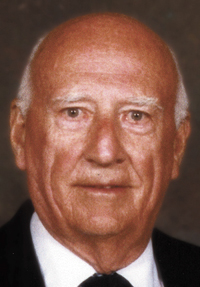Alfred J. Zaehringer
From The Space Library
RobertG (Talk | contribs)
(New page: {{Infobox |bodystyle = float:right; valign:top; |title = Alfred J. Zaehringer |titlestyle = |image = Image:Zaehringer-Alfred.jpg |imagestyle = |caption = A...)
Newer edit →
Revision as of 04:16, 9 January 2017
 Alfred Zaehringer circa 2003 | |
| Birth Name | Alfred J. Zaehringer |
|---|---|
| Birth Place | USA |
| Occupation | Engineer, Author |
| Nationality | United States of America |
| Notable Works | Rocket Science, Rocket Science The Journal of the Detroit Rocket Society |
Contents |
Early Career
Alfred Zaehringer started out by building his own rockets and then, in World War II, saw V-1's and V-2's in use against London. Moving onto the continent, he fired at them on the front lines in Germany, and also came under the attack of the first jet and rocket fighters when he crossed the Remagen Bridge.
Post War
Earning his engineering degree after the war, he formed the Detroit Rocket Society and coined the term "rocket science" and became editor of "Rocketscience" the DRS Journal. Mr. Zaehringer's first professional rocket experience came at the University of Michigan, where he dealt with anti-missile and rocket programs.
Thiokol
Then he joined the fledgling Thiokol Chemical Company and became chief test engineer. Following this he went on to the Grand Central Rocket Company, where he worked on the upper stage motor for America's first satellite. Next, he formed the American Rocket Company, where he worked on a number of rocket systems.
Apollo Program
With the Apollo program, he worked on up-rating the Saturn C-5, and the manned Mars program. Moving to Martin, he was with a solid rocket management group that looked at solid strap-ons and their effects. Coming back to LTV Aerospace in Michigan, he worked on the solid propellant gas generator for the Lance battlefield missile. He and virtually the entire propulsion group then moved to Ford Motor Company where he did engineering work on EGR valves, fuel injectors, and fuel vapor management.
Retirement
After retiring in 1995, Zaehringer has continuously devoted his time to writing about rocket science and space. He is a member of the National Space Society and the British Interplanetary Society. Author of seven books here in the US and in Europe, his book on Soviet space technology hit book shelves on the same day that Yuri Gagarin went into orbit. Mr. Zaehringer correctly predicted that the next formidable member of the Space Club would be China (China put a man into orbit in October 2003). Along with other space pioneers, his name is on the Stardust microchip and will be in space forever.
Author
He is the author of numerous papers and articles published in scientific journals, aerospace magazines and newspapers. He is the author of Rocket Science, (Apogee Books-2009), and Rocket Science - The Journal of the Detroit Rocket Society, (Apogee Books-2009).
Books by Alfred Zaehringer
Buy This Book Click here |
Buy This Book Click here |


